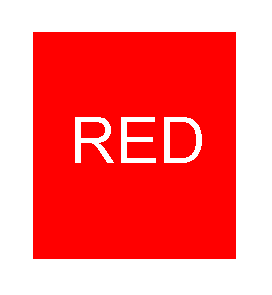Inspiration

Multiple Chemical Sensitivity
Perception - Part II
January 2013

Perception
Part II - Where is the Color
Red?
Click Here for Perception
Part I
Click Here for Perception
Part III
The big questions such as “How does the human brain interact with the true nature of reality?”, may be fun at the right sort of parties but are on the whole a little too grandiose to be practically useful. Finding a question that points in the correct direction And may actually be answerable Is a good strategy that can produce practical results. Big chunks can be broken down in to smaller chunks and smaller chunks are easier to use. “Where is the color read?”, is an appropriately ‘chunked down’ version of the larger question; a good place to get started. It may give us an answer that will be useful in gaining an insight into the much larger question about our interacting with the nature a reality.
So why red? Red is an experience we have every day, we can look around and see the color everywhere, we need no special tools to experience this phenomenon and need no special environment to have it arise. Of course all of this assumes that the person wanting to experience this is not color blind and can see fairly well, but if not one could just as easily ask about the shade of gray a color blind person links with the color red or a certain sound a blind person may hear on a regular basis. There is an old saying, Q: “What is the one thing a fish never notices?”… A: “Water”. Most of all red is something we have experienced our entire lives and have most likely taken for granted. Unlike the fish and water, red is something that has always been there but the absence/presence can be readily noticed by us even if rarely questioned. This differentiation allows for a more easily asked question.
So where actually is the color red? The easiest answer is to look around the room and just point to the first red object you see. But is it really what we are looking for? If you go up to the object and paint it blue is it still red? Not really, there may still be a layer red paint under the blue but we would not look at the freshly painted object and call it red. Even if we don’t paint it blue was the object intrinsically red or was it just coated with a chemical that reflected red light. If we investigated we would find no inherent redness to any of it, what we would find is a coating of a chemical compound that absorbs the wavelengths of light that we say are not red and reflected the one(s) that we say are red. So red is probably not an intrinsic aspect of an object or even of the chemistry of its outer layer.
What about the light that travels to our eyes, is that red? We have all seen the colors of the rainbow: Red, Orange, Yellow, Green, Blue, Indigo and Violet. Each of these kinds of light are made of different wavelengths of electromagnetic energy. When these wavelengths of light travel across the boundary of one material to another, such as air and a droplet of water in the atmosphere, they will bend in slightly different ways. These differences in the bending of the wavelengths of light will cause them to spread out, or refract, into the rainbow we see after a storm. Now let’s just look at one end of the rainbow, the red end. The red light you see, depending on how you measure it, is either made of photons that have an certain amount of energy, 2.199 electron volts, or are waves of light that have a frequency of 564nm to their wavelengths (these are the exact states of light that our eyes are best attuned to see as red). Is a specific amount of energy in a photon or a specific wavelength of light actually red? Is there inherent redness to a certain energy state of a beam of light? Many animals cannot see all the colors we can, they simply do not have the same photo receptors that we do, for them red does not exist as an experience in their realities.
Perhaps red is in the eye? At the back of each eyeball we have photo receptor cells. There are cones and rods. It is the cone photoreceptor cells that our eyes use to detect different wavelengths of light. Different cone cells posses different proteins which make them sensitive to different frequencies of light. The frequencies of light associated with blue, green, and red. Once a photon, or many photons, have struck these cells they will release a nerve signal that travels along the optic nerve.
So far we have electromagnetic energy hitting a chemical compound that absorbs some light and reflects the rest. A photon that travels across a distance to interact with a protein in a cell. Finally creating a chemical-electrical impulse that travels along a nerve fiber. None of these seemed to be a particular satisfying answer to, 'where is the color red?'
This only leaves one option left. Since the optic nerve travels to the visual centers of the brain and nothing before this point gives a proper answer, then a rather astonishing conclusion is left as the only remaining option; red only exists in the mind of the person experiencing it! Our brains are not only machines for reacting to input but are also devices for creating our sense of reality. This turns a lifetime of experience on its head. We each have spent our lives having this innate feeling that all reality is something external to us, that the color red is something we could point to as we moved about our day. We don’t normally contemplate how our brains are constantly creating interpretations from the input our senses give us that has proven useful but is not necessarily the truth of the ‘reality’ we are presently in.
Our physiology is designed to pick up and interpret useful information from the world around us. Our eyes see only a narrow band of the electromagnetic spectrum. The portion of the electromagnetic spectrum that our sun puts out, and that our atmosphere allows to pass through. Our eyes have adapted to respond to the frequencies of light that are most abundant in our environment. If our sun burned slightly hotter or cooler then the type of light given off would be different. If the composition of the atmosphere were made of different chemicals then the light that actually hit the ground would also be different. If the light that we are all awash in was different then our eyes would have adapted to gather that portion of the spectrum and not the one we now see. But there are variations within the portion of the electromagnetic spectrum that we can see and color is just the way our brains have created to quickly allow us to distinguish between these diverse wavelengths of light. The same is true for other senses as well, our ears hear the frequencies of sound that are most useful with tone being our brains short cut allowing us to easily distinguish between different wave lengths of vibrations in the air. We smell what is needed and we taste what helps us survive, with our brains interpreting singles from these various chemical detectors as sweet, sour, pleasant or unpleasant as has been useful for our ancestors survival.
There is nothing inherently red about a cetin wavelength of light, there is no C sharpness about a specific vibration of sound, there is nothing sweet on its own about a glucose molecule; the object or event may exists outside of our experience but the attributes our mind assigns to them exists nowhere else in the universe. Red only exists in the visual cortex of the human (and potentially some other animals’) brain.
A good example of this may be found in a cat and a television. The old style picture tube TV did not necessarily create a true picture on the glass screen that you watched. There was actually a rather small and very fast dot that went from left to right and from top to bottom across the screen in front of you. As it passed it would at times be brighter and at other times be dimmer. It would also be projected at different frequencies that would excite different sets of chemicals on the inside of the picture tube thus lighting up different colored pixels as the beam passed by. On one pass it would light up the odd numbered lines of resolution and on the next pass it would light up the even numbered lines of resolution. It would actually take two passes down the TV to make one picture. Now since we humans have a rather slow rate of visual acuity we would see this dot as blurred together to create a series of pictures that would tell a moving story. Now your cat is naturally a predator and to survive needs to see much faster than we do. A small bird moving fast in front of us

is little more than a blur, to your cat this is a very clear event. Because of this much faster rate of visual acuity your cat doesn’t not see a picture when it looks at the TV, what it sees is a dot moving from left to right and from top to bottom across the screen. Where your cat may actually see a closer approximation of the truth we humans see the latest DVD movie we just rented. The visual centers of your cat’s brain sees a dot, the visual cortex of our brains build up an illusion that can keep us enraptured for hours. The experience of the movie you watched existed only in the brain of the human observer.
It is important to not reduce this line of logic to the conclusion that nothing exists outside of the human experience. There are events external to us that can be measured, recorded, analyzed and predicted. A mass of raw data from a scientific experiment may not be useful on its own; it must be analyzed, organized and scrutinized to tease out the useful information. Our brains are doing the same thing for us all the time by taking in information from the senses and interpreting this information in ways that can be quickly used by our minds. It will create easily interpreted shortcuts such as color, tone, texture, sweet tastes and many other often not thought about experiences to assist us in our job of negotiating and surviving the world we live in.
The world our species was designed for has long since vanished. We no longer travel in tight nit family groups of 20 to 40 people hunting and gathering for our survival. The lives we live today may demand a very different way of looking at the world then our ancestors were hardwired for. The question we humans have to ask ourselves is if we are willing to become aware of these perceptual creations; and if so decide what is useful for our present lives and what is not. If changes need to be made by us it may be advantageous to acknowledge and perhaps enen move beyond this ‘reality’ that our minds are designed to create. Are we willing to take what is useful and when needed look further than what is not?